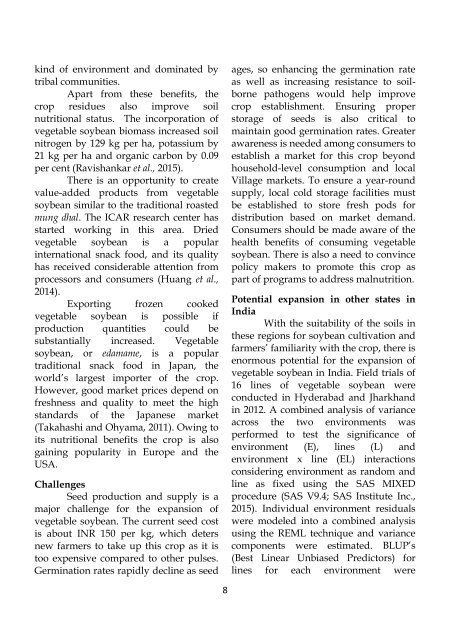SOYBEAN RESEARCH
Soybean-Research-14(2)-2016
Soybean-Research-14(2)-2016
Create successful ePaper yourself
Turn your PDF publications into a flip-book with our unique Google optimized e-Paper software.
kind of environment and dominated by<br />
tribal communities.<br />
Apart from these benefits, the<br />
crop residues also improve soil<br />
nutritional status. The incorporation of<br />
vegetable soybean biomass increased soil<br />
nitrogen by 129 kg per ha, potassium by<br />
21 kg per ha and organic carbon by 0.09<br />
per cent (Ravishankar et al., 2015).<br />
There is an opportunity to create<br />
value-added products from vegetable<br />
soybean similar to the traditional roasted<br />
mung dhal. The ICAR research center has<br />
started working in this area. Dried<br />
vegetable soybean is a popular<br />
international snack food, and its quality<br />
has received considerable attention from<br />
processors and consumers (Huang et al.,<br />
2014).<br />
Exporting frozen cooked<br />
vegetable soybean is possible if<br />
production quantities could be<br />
substantially increased. Vegetable<br />
soybean, or edamame, is a popular<br />
traditional snack food in Japan, the<br />
world‘s largest importer of the crop.<br />
However, good market prices depend on<br />
freshness and quality to meet the high<br />
standards of the Japanese market<br />
(Takahashi and Ohyama, 2011). Owing to<br />
its nutritional benefits the crop is also<br />
gaining popularity in Europe and the<br />
USA.<br />
Challenges<br />
Seed production and supply is a<br />
major challenge for the expansion of<br />
vegetable soybean. The current seed cost<br />
is about INR 150 per kg, which deters<br />
new farmers to take up this crop as it is<br />
too expensive compared to other pulses.<br />
Germination rates rapidly decline as seed<br />
ages, so enhancing the germination rate<br />
as well as increasing resistance to soilborne<br />
pathogens would help improve<br />
crop establishment. Ensuring proper<br />
storage of seeds is also critical to<br />
maintain good germination rates. Greater<br />
awareness is needed among consumers to<br />
establish a market for this crop beyond<br />
household-level consumption and local<br />
Village markets. To ensure a year-round<br />
supply, local cold storage facilities must<br />
be established to store fresh pods for<br />
distribution based on market demand.<br />
Consumers should be made aware of the<br />
health benefits of consuming vegetable<br />
soybean. There is also a need to convince<br />
policy makers to promote this crop as<br />
part of programs to address malnutrition.<br />
Potential expansion in other states in<br />
India<br />
With the suitability of the soils in<br />
these regions for soybean cultivation and<br />
farmers‘ familiarity with the crop, there is<br />
enormous potential for the expansion of<br />
vegetable soybean in India. Field trials of<br />
16 lines of vegetable soybean were<br />
conducted in Hyderabad and Jharkhand<br />
in 2012. A combined analysis of variance<br />
across the two environments was<br />
performed to test the significance of<br />
environment (E), lines (L) and<br />
environment x line (EL) interactions<br />
considering environment as random and<br />
line as fixed using the SAS MIXED<br />
procedure (SAS V9.4; SAS Institute Inc.,<br />
2015). Individual environment residuals<br />
were modeled into a combined analysis<br />
using the REML technique and variance<br />
components were estimated. BLUP‘s<br />
(Best Linear Unbiased Predictors) for<br />
lines for each environment were<br />
8


